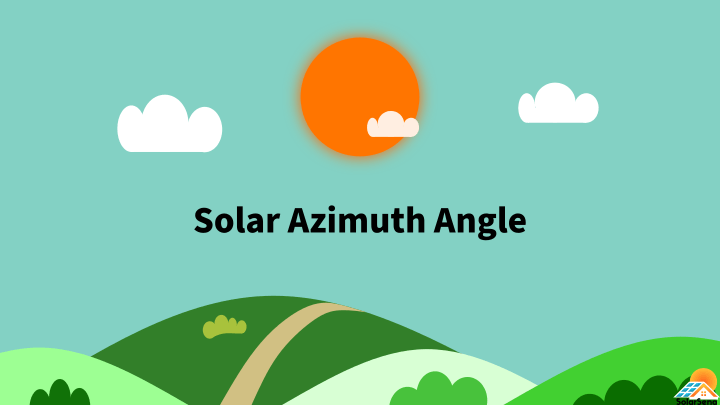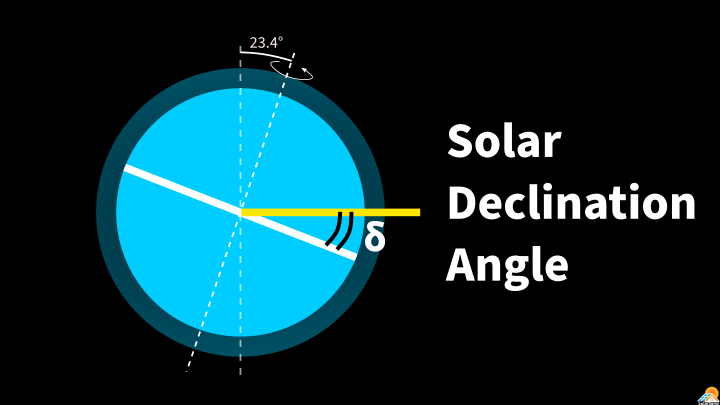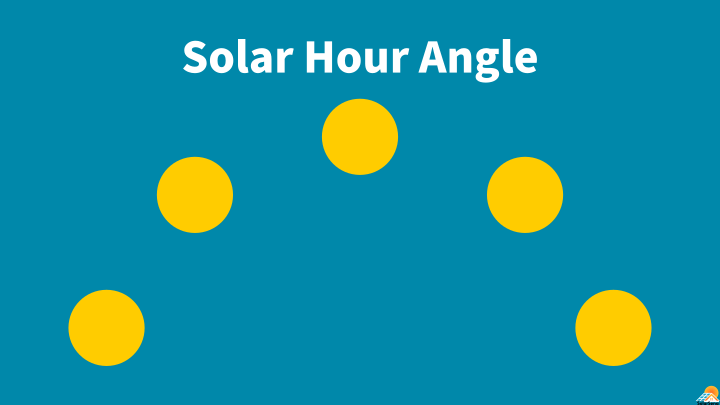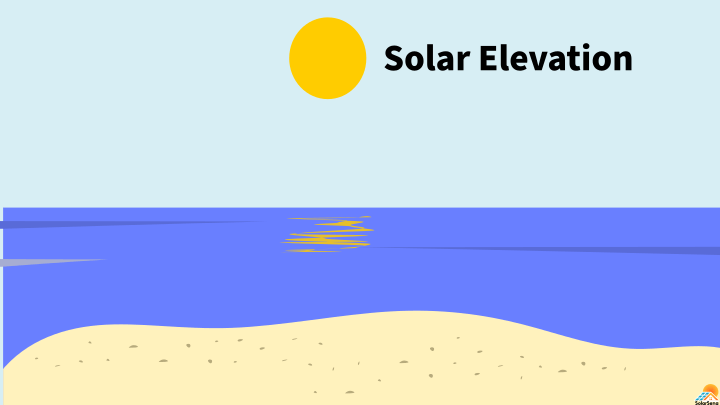The solar azimuth angle is a way to identify the position of the sun in the sky. It defines the horizontal position of the sun on the local horizon. Knowing the azimuth angle of the sun is an essential aspect in deciding the orientation of solar panels.
Solar azimuth angle calculator
Select your date & time of the day, your time zone from UTC and enter your longitude & latitude to calculate the solar azimuth angle.
What is the solar azimuth angle?
The solar azimuth angle defines the horizontal coordinates of the sun relative to the observer. It is defined as the angular distance between the projection of the sun on the imaginary horizontal plane on which the observer is standing and the reference direction. In solar technology, the reference direction is north.
There are other conventions, but here we will stick with National Renewable Energy Laboratory (NREL) standards. Thus, the azimuth angle is the angle between the north and the sun on the local horizon with the observer. The angle is positive clockwise and negative counterclockwise—see the figure below.

As per the convention in the above diagram, the azimuth angle is 90° when the sun is along the east direction and is 180° along the south. When the sun is west to the observer, the azimuth angle is 270° (or −90°).
The azimuth angle varies throughout the day. In the morning, the sun is east; the azimuth angle will be close to 90°. It can be greater or less than 90° that depends upon your location (latitude and longitude).
As the sun ascends in the sky, the azimuth angle may increase or decrease depending upon your latitude and longitude and the day of the year.
In the evening, during sunset, the azimuth angle will approach toward 270°.
Solar azimuth angle formula
The azimuth angle is calculated using the following formula:
Here, A is the azimuth angle, δ is the declination angle, φ is the latitude, h is the hour angle, and ɑ is the solar elevation angle.
The hour angle (h) can be positive (after solar noon) and negative (before the solar noon). When h is positive, we have to subtract A from 360°.
You can find your latitude from any standardized online maps, e.g., Google Maps.
How do you find the azimuth angle?
You need to first estimate the declination angle, hour angle, and solar elevation angle to find the azimuth angle.
Quick and simple equations to estimate these variables are as follows:
For the declination angle,
Here, d is the number of days since January 1st UTC (00:00: hr).
For hour angle,
Here, LST is the local solar time in hours.
For the solar elevation angle,
Once we find all three variables, we can substitute them into the above-mentioned formula to determine the solar azimuth angle.
Example
Let us take an example to make things more clear. Tucson, Arizona, is at 32.22° N latitude. We want to find the solar azimuth angle at 10:00 AM, 12:00 noon, and 2:00 PM on March 3rd.
The solar hour angle at 10:00 AM will be 15°× (10−12) = −30°. Similarly, at 12:00 noon & 2:00 PM will be 0° & 30°.
The number of days from January 1st to March 3rd is 31+28+2 = 61.Substituting d = 61 days,
Now, we have δ = −8.01°; φ = 32.22°; and h = −30°, 0°, 30°.
ɑ for h = −30° is calculated as:
The elevation angles for the other two timings are 49.77° (12:00 noon) and 40.63° (2:00 PM).
Finally, we can find the azimuth angle as follows:
Similarly, A for the other two are 176.92° (12:00 noon) and 139.27° (2:00 PM).
2:00 PM is past solar noon, so A = 360−139.27 = 220.73°.
According to the above calculator, A = 129.40° (10:00 AM), 165.86° (12:00 noon), and 210.57° (2:00 PM).
These angles from the calculator differ from those calculated manually. That is because the equations used in the above calculation are approximated and always give an error of a few degrees, whereas the calculator uses more rigorous equations.
Variation in the azimuth angle
The solar azimuth angle changes every single second. In the morning, it will always be around 90°, and in the evening, the angle will approach 270°. From morning to evening, the angle may decrease or increase depending upon your location and time of the year.
The graph below represents the daily variation of the azimuth angle of Tucson and Sydney on March 3rd. Tucson is a city in Arizona, US, and in the northern hemisphere, while Sydney is in the southern hemisphere. We can see how dramatic the difference is in the solar azimuth angle for different locations.

As we see from the previous graph, in Tucson, the azimuth angle increases gradually throughout the day.
On the other side, in Sydney, there is a gradual decrease in the angle, but in the afternoon, we see a spike from 0° to 360°. This rapid shift in the graph does not imply a sudden change in the sun’s position in the sky. In fact, the sun keeps moving at its normal pace, and the azimuth angle keeps gradually decreasing since 360° is equivalent to 0°.
The solar azimuth angle does not only vary throughout the day for different locations but also changes monthly for the same location.
The graph below depicts the monthly variation in the azimuth angle for Denver, Sydney, Macapa, and Austin at 12:00 noon.

Sydney, which is in the southern hemisphere, has a lower azimuth angle than Austin and Denver, which are in the northern hemisphere. Macapa, which is close to the equator, fits in between the other curves and has a drastic up and down.
The difference between elevation and azimuth angles?
The elevation and azimuth angles are important in deciding the position of the sun, but both angles are different measurements. Azimuth tells the horizontal coordinates of the sun, while elevation is about the vertical coordinates. The elevation angle gives us the altitude of the sun in the sky.
The diagram below explains the same.

The relation between both is not simple. The graphs below give daily and monthly variations in the angles at Tucson.


Solar azimuth angle and solar panels
The understanding of the solar azimuth angle is a vital aspect of photovoltaic and thermal design. Solar power production is maximum when solar panels are right in front of the sun.
Since the azimuth angle dictates the horizontal coordinates of the sun, our solar panels must be angles at the azimuth angle to get maximum solar power.

The position of the sun in the sky changes continuously. And it is impossible to synchronize the direction of solar panels with the position of the sun unless you are using a solar tracking system. Solar tracking is an unaffordable and uncommon option for homeowners and small projects.
Most times, solar panels are permanently fixed in a particular direction. This optimal direction of solar panels is decided by the solar azimuth angle.
If you have carefully looked at one of the preceding monthly variation graphs, you must have noticed a relationship between the solar azimuth angle and location. For Sydney, which lies in the southern hemisphere, the azimuth angle always remains below 90° at noon over the entire year. Thus, people in Sydney will always see the sun in the northern sky. It is also true for other cities in the southern hemisphere. That means the sun appears in the north for regions in the southern hemisphere, so the best direction for solar panels will be south.
With the same reasoning, solar panels in Austin, Tucson, and Denver must be oriented toward the south direction. The azimuth angle always remains more than 90° for these cities at noon; they are in the northern hemisphere. People in the northern hemisphere will see the sun in the southern sky.
FAQs
What is the solar azimuth angle?
The solar azimuth angle is the angle between the sun and the reference direction (usually north) with the observer on the local horizon.
What is the difference between the solar azimuth angle and the solar elevation angle?
The solar azimuth angle defines the horizontal coordinates of the sun, whereas the solar elevation angle decides the vertical position of the sun or its altitude.
What is the solar azimuth angle for sunrise and sunset?
The solar azimuth angle for sunrise will be close to 90° and for sunset will be close to 270°.



